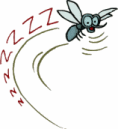|
|
 During the summer months, a common problem for dogs with erect ears (prick-ears) is fly-bite dermatitis. The common stable fly, Stomoxys
calcitrans, causes damage to the edges and tips of the ears as it feeds. The flies’ bites result in severe irritation to the skin, producing bloody crusts and scabs. Common clinical signs include head shaking and scratching at the ears. Once the damage occurs, treatment consists of application of medicated ointments and eliminating the ongoing irritation by the flies. During the summer months, a common problem for dogs with erect ears (prick-ears) is fly-bite dermatitis. The common stable fly, Stomoxys
calcitrans, causes damage to the edges and tips of the ears as it feeds. The flies’ bites result in severe irritation to the skin, producing bloody crusts and scabs. Common clinical signs include head shaking and scratching at the ears. Once the damage occurs, treatment consists of application of medicated ointments and eliminating the ongoing irritation by the flies.
They may also bite the bridge of the nose. They are biting the dog to obtain a blood meal and the bite is often painful. Because of the thin skin and hair on the ears and the inability of the dog to defend his ears, flies will seek out this location. Some of these dogs will endure hundreds of bites a day for weeks at a time. Anyone that has ever been bitten by a stable fly knows how painful the bite is. If you see blood spots or flies congregating near your dog's ears then you can assume fly bites are occurring. The bite wounds attract flies which may lay their eggs in the damaged tissue. These will later hatch into maggots.
Whether you live in the city or country, do not underestimate the pain that these flies can inflict and be sure to initiate treatment at the first sign of fly bites on your pet. Gently cleanse the ear with warm water and a mild antiseptic soap. Then, apply a topical antibiotic ointment which will help to control any infection which may be present. If the fly bites are severe, or maggots are present, veterinary attention is needed.
 One method of preventing this problem is to keep the dog inside during the day. As an alternative, fly repellent ointment may be applied to the ear tips. When properly applied at appropriate intervals, these products can control the flies that cause the irritation and damage. Fly repellent ointments can allow your canine friend to enjoy the day outside without the annoying fly bites. One method of preventing this problem is to keep the dog inside during the day. As an alternative, fly repellent ointment may be applied to the ear tips. When properly applied at appropriate intervals, these products can control the flies that cause the irritation and damage. Fly repellent ointments can allow your canine friend to enjoy the day outside without the annoying fly bites. |
|
|
| FLY TYPES |
|
-
Stable flies (Stomoxys calcitrans) has rasping teeth with blades to attack the skin of animals. They feed off the blood and exudate from wounds on the animal. Crusted ulcerated ear wounds are often created from the flies' bite. The lesions may be itchy and certainly the flies worry the animal.
Stable flies are similar in size and appearance to houseflies. These tend to bite on the tips of the ears, especially on dogs with erect ears.
- House flies cause minor nuisance feeding on eye and nose secretions and wound exudate.
- Horse flies (Tabanids) bite pieces of skin out to feed on the exudate and blood. The bite is painful. The largest biting flies are
the horse flies. They generally bite pets on the back and leave painful wounds with bloody crusts.
-
Deer fly (Chrysops) and mosquitoes also cause annoying bites. All insect bites can cause allergies greatly increasing the irritation and itch. Deer flies, which are about one-third of an inch long and have yellow and orange markings, generally bite pets on the back and leave painful wounds with bloody
crusts.
- Fly maggots can infest old animals that become wet from urine scald and cannot move.
-
Buffalo flies (Haematobia irritans) are a severe problem in tropical Australia during the late summer.
Black flies, also known as buffalo gnats, are smaller biting flies, about one-eighth of an inch long. This species breeds in running water and fly in swarms. Bites usually occur in the early morning or late evening on the inside part of the ear.
|
|
|
| FLY STRIKE |
|
|
This is only an occasional problem in dogs and cats, but if your pet has this problem, they'll be miserable and painful.
 Fly Strike is simply where biting flies have targeted your pet's ear flaps. Perhaps because of a minor cut , wound, sunburn damage, or the attracting smell of an ear infection. Once the flies start biting the problem becomes a
vicious cycle with the irritation, ooze, and dried blood from the fly bite wounds attracting more flies. The pet then scratches the ear flap causing further irritation and bleeding. Fly Strike is simply where biting flies have targeted your pet's ear flaps. Perhaps because of a minor cut , wound, sunburn damage, or the attracting smell of an ear infection. Once the flies start biting the problem becomes a
vicious cycle with the irritation, ooze, and dried blood from the fly bite wounds attracting more flies. The pet then scratches the ear flap causing further irritation and bleeding.
The Solution is also fairly simple:
-
Clean and treat the ear flaps. Your vet will
prescribe a soothing and medicated ointment or cream or suggest using a "human" product that you may already have at home.
-
Stop the irritation and itch cycle. This usually means using antihistamines, short term prednisone (steroid), and maybe some pain medication (but not aspirin (prevents clotting) or
Tylenol (toxic to cats and not all that safe in dogs either))
-
Treat the underlying problem of ear mites, infection, etc if present.
-
AND GET RID OF THE FLIES. The best way is to move your pet inside or to a different area if possible. If not, then clean up the yard, the garbage, and the stools that attract fly populations. If that's not easily done, such as around barn yards, then use fly repellents twice daily on the ear flaps until they are well healed. Avon Skin So Soft Lotion or Oil works fairly well as do most of the pyrethrin based fly repellents made for horses.
If you don't know about Avon Skin So Soft, it's a brand of women's skin moisturizer that just happens to be a fairly good insect repellent for humans and pets. It seems to work well diluted about 1 part Avon SSS oil to 9 parts water or any brand of water based skin lotion. Or you can apply it full
strength, but then it's a little greasy. Or you can simply buy the Avon SSS Lotion ready to go. It's what I use for mosquitos when fishing or out in the field and it works well for about half a day. It's lightly scented, so you might have to explain the perfume smell to your wife. At any rate, it's gentle, soothing, and effective on cat and dog ears for repelling flies and other biting insects.
Animal Pet Doctor |
|
|
| HOME MADE FLY
REPELLENTS |
|
|
|
Dilute 1ml of Permoxin in 40mL of Vaseline or baby oil and mix well. If a consistency less than thick Vaseline or more
than baby oil is desired these two ingredients can be mixed in the desired proportion to give the desired consistency
after the Permoxin is added.
Add the baby oil/Permoxin mixture to the Vaseline/Permoxin a little at a time until the desired ointment consistency is
reached. This will keep for the summer months, then discard.
This ointment can be applied on wounds to help healing and prevent flies from further
irritating the wound. |
|
|
| FLY SPRAY |
|
|
- 1 oz citronella oil
- 1 cup Cider Vinegar
- 1 cup Water
- 1 basil leaf
- 1 bay leaf
|
 |
|
Some dogs (and people) may be allergic to citronella oil. Before using the citronella in your fly
repellent, test it on a small part of your dog's skin. If your dog has a reaction to the citronella you should use two tablespoons of lemon scented dish detergent instead. |
|
| TIPS |
|
- Try putting Vicks Vapo-rub on the ears
- Keep the dog inside during the day
- Try Vaseline on the ears
|
| LINKS |
|
|
|
| |


• Fleas • Ticks •
Lice • Babesiosis • Natural
Flea & Mosquito Remedies •
•
Bee Stings •
Spider Bites •
Fly Bites • Toads
• Snake Bites & Vitamin C •
Heartworm •
•
Repellent Plants •
Snake Proofing Fences • Handy
Hints • First Aid • General Links
•

E-mail
Us to report a broken link!
|
|